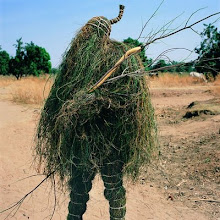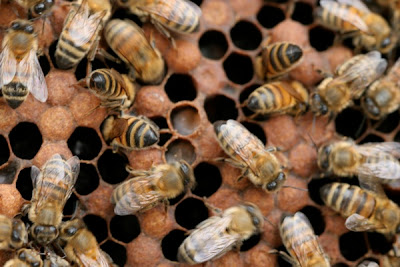Right now it is composed of two deeps and one super, all for brood. I checked the entrance and the bees seemed calm. I lost my calm when I opened up the lid and found this lurking on the inner board. It is about the size of a quarter.
The hive is bursting out of the top board. A good sign.
The top super contained a lot of capped and uncapped honey, some spotty drone and worker brood and pollen. When I pulled out one of the frames I saw it was connected to the middle box by a few rows of drone larvae. They were torn open in the process, so I was able to photograph what the bee larva looks like. Once I got the camera in there I could see that the drone larvae had some of the Varroa mites attached to them. They are big and red and look like a flat tick. They are more attracted to drone brood for some reason, so one of the ways you can clear them out of your hive is to throw out all the frames that have drone brood. there is a special frame designed just for that method. I bought one last year and maybe I will end up using it.
You can see the mites in this photo in the upper right corner of the photo.
It is the red disk on the white body. Here is a closer look.
As if having a big ugly red parasite on you as a baby bee maggot is not insulting enough, when the bees hatch their wings are deformed and they are weaker than their healthy sisters. I saw a few bees that had been damaged by the mite and got a pretty good photo of one.
Here is an adult worker bee that has one.
It does not have the damaged wings, so it must have gotten this parasite after it hatched.
The middle deep had a beautiful brood pattern, pollen, honey. The works. The bottom deep was completely empty of bees. There were the four frames of capped honey I had put in there at the beginning of winter and the rest were empty drawn comb. The queen had moved her operation upstairs, as they tend to do. Time to do a little swapping of boxes. I put the middle and upper boxes full of brood and bees on the bottom and moved the empty deep to the top of the hive so the queen could keep moving upwards and building up her colony for spring. I also took their entrance reducer off since they seemed to have plenty of guard bees.
By this time the weather had turned cold and windy and the bees were pretty irritable. they were loudly buzzing and pelting me with their little bodies. I could smell the familiar banana scented alarm phermone and figured now would be a great time to close them back up. Below you can see in the lower left corner, the bees are having a little conference about how they are going to try to get that big white suited guy the heck away from the nest.
Next up: applying powdered sugar to the bees and catching the falling mites on a stickyboard.












Ah, what a lovely bee blog this is. Reached here through urban field guide blog and liked your posts. I love bees and you may find some on my blog as well.
ReplyDeletethanks, I will check yours out.
ReplyDeleteWow. Those varoa mites are really upsetting.
ReplyDeleteI'm hoping to start keeping bees in East Oakland later this spring.
They are so large compared to the bee. I wish I could pick them off each bee I see them on, but the bees are not too cooperative. ;)
ReplyDeleteI wish you luck with your new bees.